Beloved LDS artist James C. Christensen passed away on January 8, 2017, after an ongoing battle with cancer. For more than 35 years he delighted the world with his whimsical yet spiritually profound art. Here is a look back at what he had to say about his art, as well as a gallery of some of our favorite paintings.

Photo by Bradley Slade for LDS Living
With every stroke of his brush, James C. Christensen became one of the world’s most beloved artists. Best known for his whimsical paintings of “poofy guys” and floating fishes, flying boats and flying pigs, Christensen captivates his audience with his fascinating realm of make-believe. And while most people are enchanted with his paintings at first glance, if they look a little closer, they can usually learn a few eternal principles as well.
Christensen’s work is unique and eclectic. He has depicted Catholic saints and sinners in the style of the Renaissance masters, and he has painted events and parables from the scriptures. Of course, he is most famous for his fantasy paintings, and interestingly enough it is many times in his most imaginative creations that you can spot LDS themes—where humans are eternal beings, often striving to better themselves; where the Everyman struggles to shine his light in a dark world; and where characters show courage and faith in the midst of adversity.
Throughout his career, Christensen made a point of describing himself not as a Mormon artist, but an artist who is Mormon. And although early on he thought he kept his art and faith separate, he now says, “Looking back, I can see that my faith seeped into everything,” he told LDS Living in 2012.
He decided long ago that he would choose his subjects carefully, avoiding confrontation and negativity. “I want my work to communicate values that are positive and uplifting, to encourage people to be happy and enjoy life. There is enough darkness in the world—I’m trying to build the kingdom with the gift that I’ve got.” He added, “As I’ve gotten older and become more well known, I’ve realized very much that I have a responsibility as a Church member.”
As Christensen tried to share inspirational messages in his own unique way, he found great success in touching people from all walks of life.
He recalled, “Years ago, I had a show, mostly fantasy, but there were messages in it. A man came up to me afterward and said, ‘You know something. There’s something in this work. I don’t know what it is, but it’s good and I want to know about it.’” He continued, “I said, ‘I do know something you don’t know—I know what I have to do to be happy. I have a couple of friends I can put you in contact with.’ And he agreed.”
Opportunities like this were not unusual for Christensen, and it is often through two of his most common and beloved characters—the hunchback Everyman and the poofy guy—that he is best able to reach people. While they may seem to be just fantastical, quirky beings, their meanings run much deeper.
“The hunchback is Everyman—male or female, adult or child,” he explained. “All of us have humps. We’re all imperfect. Some of our humps show, some of them don’t. It’s the idea of the imperfect person trying to figure things out.” In fact, he said that more than any other painting, he received expressions of gratitude for his 1992 painting entitled Sometimes the Spirit Touches Us through Our Weaknesses.
Similarly, the poofy guys represent human foibles and failings. Their many layers of fancy clothing make them almost spherical, restricting movement and progression. “The clothes of these poofy guys became a metaphor for human baggage, all the things that make us feel important,” Christensen said.
Overcoming weaknesses or becoming humble so we can learn from our mistakes are not new concepts to Latter-day Saints, but they are often novel ideas to other people. In fact, sometimes what Christensen originally views as a very LDS idea has amazing appeal with his general audience.
“I’m always surprised when I throw in what I see as an LDS theme how many others find it a universal idea,” he told LDS Living.

Photo by Bradley Slade for LDS Living
One of Christensen’s most obvious Mormon themes appeared in a 2007 painting entitled Hold to the Rod, the Iron Rod. In it, the character is burdened with dozens of objects he has collected to make himself feel confident and safe. “They may be material possessions, but they may also be titles or responsibilities,” he added. The man longs to reach up and hold the iron rod above him, but he is afraid to let go of his belongings.
At first, Christensen dismissed the painting as something viewers at large would not be interested in, but Scott Usher, Christensen’s publisher, convinced him otherwise. “The painting was in my studio because I was having a show. Scott, who is not LDS, asked, ’What’s that?’ I told him it was a Mormon thing and that it didn’t have much relevance outside the LDS audience. He said, ‘Yes, it does. We all have to make that decision. Whatever our iron rod is, we all have to decide what’s important.’ That image sold all over the country and was gone within a few days.”
With his uncanny ability to create not only worlds of whimsy and imagination, but also to reach beyond facades to touch the hearts of people everywhere, there is no doubt that the world is a more magical place with James C. Christensen's art in it. He consistently found a way to lift the spirits of others with his art, whether that means simply entertaining them or teaching them with symbolism and deeper meaning.
“Some of my art just tickles your imagination,” he said with a twinkle in his eye. “I want to inspire people, but I inspire with imagination. Some of the goofy fun stuff gets somebody interested in my work, and sometimes they get to feel the Spirit later.”
In his 2012 book, Passage by Faith: Exploring the Inspirational Art of James Christensen, he described the spiritual elements in his work and unveiled the visual metaphors, symbols, and "meaning behind the meanings" of some of his most popular fantasy pieces, as well as his deeply meaningful scriptural images. Here are some of our favorites.

Hold to the Rod, the Iron Rod
This "poofy guy," as Christensen called him, represents human foibles and failings. His many layers of fancy clothing make him almost spherical, restricting movement and progression. In this painting, he is so burdened with "stuff" that he cannot reach up to hold to the rod above his head for fear of losing any of the material possessions he has accumulated throughout his life.
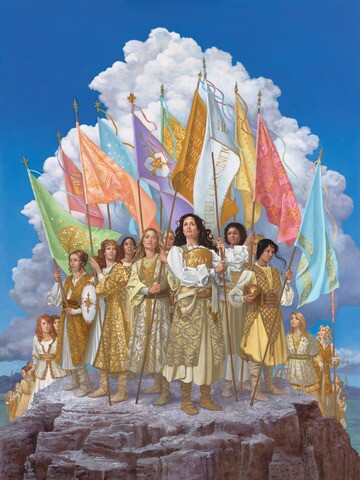
Arise and Shine Forth
For this painting, Christensen was inspired by the following statement by Young Women General President Elaine S. Dalton: "Now is the time for young women everywhere to 'arise and shine forth, that they light may be a standard for the nations." He explains, "I designed the painting not as an intimate personal moment, but as a triumphant gathering of noble spirits, carrying the banners and standards of battle."
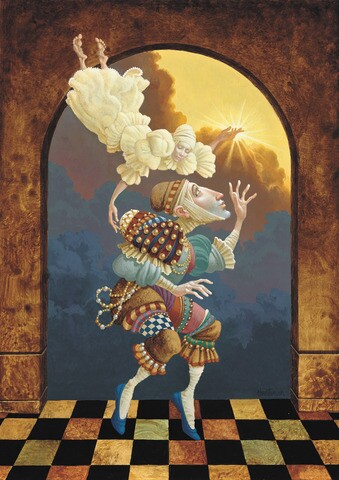
After the Clouds, Sun
In this painting, the hunchback, or Everyman, is responding to the Spirit, which has touched his hump--or his weakness. The sun is appearing from behind the clouds, and the angel is directing him, not just touching him. Christensen said, "So many times it's through the hard things that we find the greatest spiritual blessings."

Ten Lepers
"This painting is about gratitude, about recognizing the gifts of the Savior in our lives on a daily basis," Christensen explained. "I think we too often fail to realize the blessings that He gives us and, even in our excitement to take advantage of our good fortune, we forget to acknowledge the source of all good things in our lives."

Angel Unobserved
Christensen said, "Our connection with the Divine is real, and if we are willing to listen, it will guide and protect us." What about the wings on the angel? He explained, "I like to identify heavenly beings the way artists have done for centuries, by giving them wings."
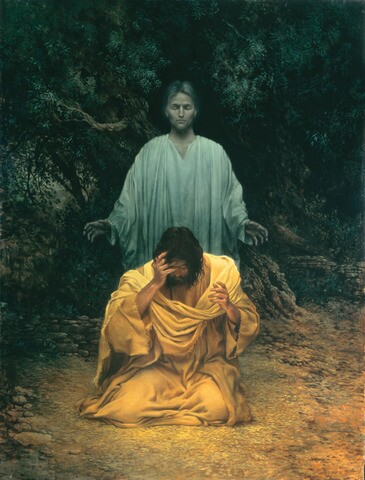
Gethsemane II
"When I went to paint that pivotal moment as Christ undertook the Atonement of the world, I wanted to focus on how the angel from heaven strengthened Him as He accepted the will of the Father and began to suffer for our sins," Christensen wrote. "I don't think the angel was there to soothe Him or force Him to accept His fate."
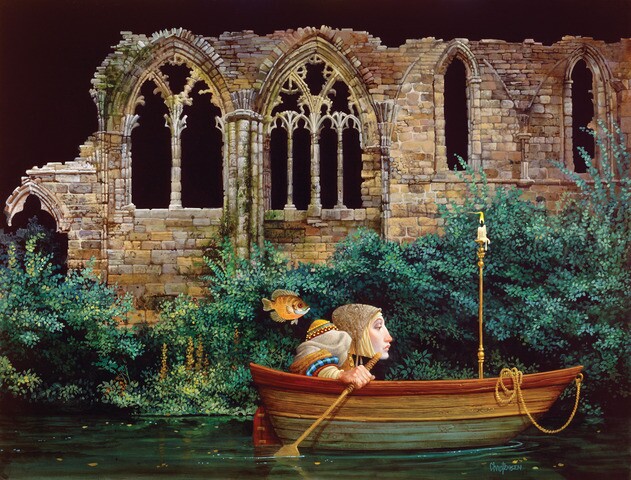
Passage by Faith
Here, Christensen uses the river as a metaphor for the journey of life. The character in the boat is called the Everyman, and his hump represents each of our weaknesses. The fish is a symbol of wisdom and magic, and the candle represents his faith, lighting the way.

Lehi Beheld the Fruit
The model for this painting grew up in California in a citrus grove. He was using an orange as a prop when Christensen captured this gesture and expression. The model's wife explained, "To this day, when he smells an orange, it brings to mind all the love and comfort and Christmases and wonderful times with the family of his childhood." Christensen wrote, "I think those memories reflect beautifully the feelings that Lehi expressed and would have wanted to share."

One Light
Here, the Everyman is sitting on a checkerboard, which symbolizes the game board of life and opposition in all things. The skull in his cap is evidence that he is aware of his mortality. Despite his vulnerability and frail mortality, he lets his light shine. Christensen wrote, "You may be only one little lamp with a light, but if there are enough of us letting our lights shine, we'll light up the universe."
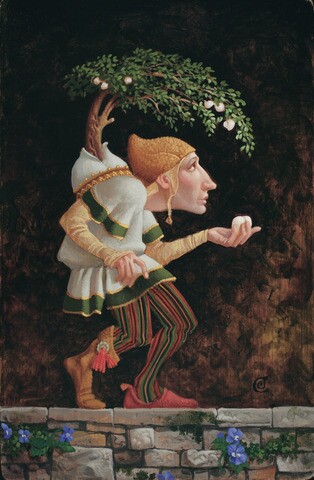
The Fruits of Adversity
"The Everyman is enjoying the white fruit of the tree of life, but the tree is coming from his hump--from his trials and adversity," Christensen explained. "He's walking on the strait and narrow path, which happens to be on top of a wall in this painting, but it's through the adversity he has endured that he is able to enjoy the fruit."
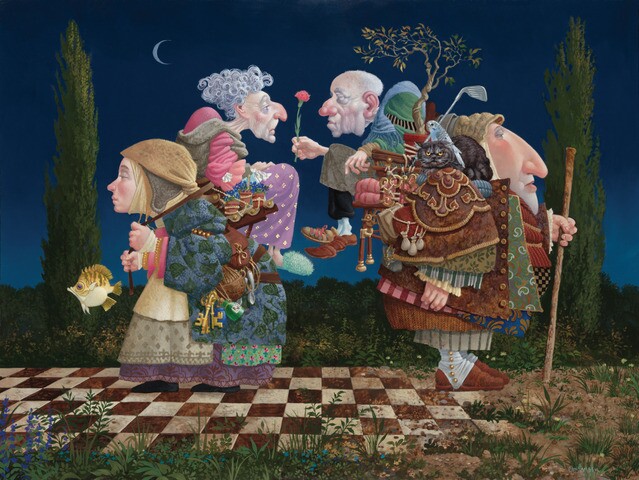
Twilight
Christensen worked on this painting while his wife's parents, both suffering from medical ailments, came to live with them. The younger couple aren't facing each other because they are sacrificing time together to ensure their parents' well-being. "One of the most beautiful things we learned in the process was that despite the physical challenges and the memory loss and dementia that accompanied their old age, their love for one another endured," Christensen wrote. The pink carnation in the painting symbolizes that undying love.

Touching the Hem of God
Christensen said this painting is about capturing "the woman's believing heart and that magical moment when she touches Christ's hem with the certainty that is faith in action and feels herself being made whole." The red ribbon symbolizes her health problem--what the Bible calls "an issue of blood." The checkerboard pattern is a symbol of life and death, good and evil. The light at the end of her finger represents the powerful moment when she touches His robe.
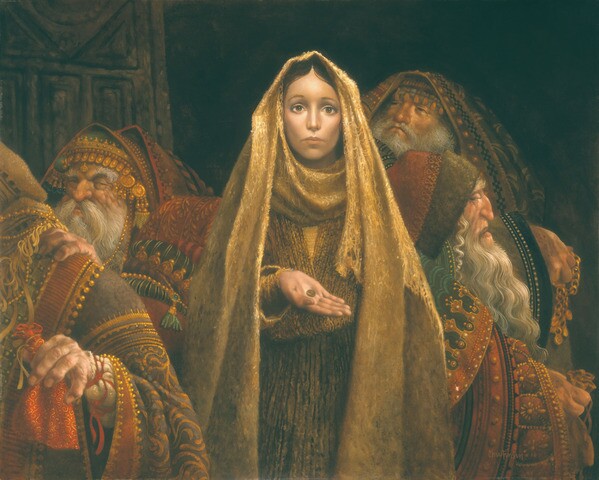
The Widow's Mite
This painting represents an interchange between Christ and His disciples that occurred in the temple at Jerusalem. Christensen wrote, "From where he was sitting, Jesus could see 'the rich men casting their gifts into the treasury' (Luke 21:1). As He watched, a poor widow came and, in contrast to the offerings of the rich men, put in just two mites." Notice that Christensen painted the rich men in fantasy style in stark contrast to the widow.


